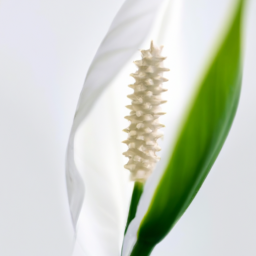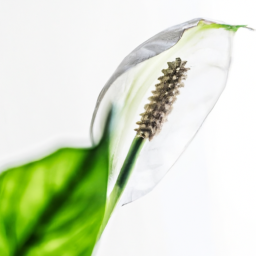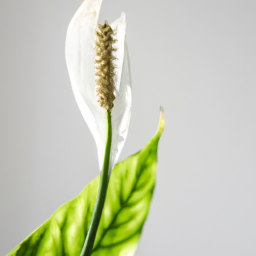
Are you a fan of peace lilies but want to learn more about the different types available? Well, you’re in luck! In this blog post, we will explore the various varieties of peace lilies that you can add to your indoor garden. From the classic Spathiphyllum wallisii to the striking Sensation peace lily, there are so many beautiful options to choose from. Let’s dive in and discover the unique characteristics of each type of peace lily and how you can care for them to keep them thriving in your home.
Types of Peace Lily Varieties
Common Varieties
When it comes to peace lilies, there are several common varieties that you may come across. One of the most popular varieties is the Spathiphyllum wallisii, which is known for its elegant white flowers and dark green leaves. This variety is perfect for adding a touch of beauty to any indoor space.
Another common variety is the Spathiphyllum cochlearispathum, which is similar to the wallisii but has slightly larger leaves. This variety is also known for its white flowers and is a great choice for those looking to add a pop of color to their home.
If you’re looking for a more unique peace lily variety, you may want to consider the Spathiphyllum floribundum. This variety has smaller flowers than the wallisii and cochlearispathum, but it makes up for it with its abundance of blooms. The floribundum is a great choice for those who want a peace lily that will really stand out.
Rare Varieties
In addition to the common varieties, there are also some rare peace lily varieties that you may be lucky enough to come across. One of these rare varieties is the Spathiphyllum cannifolium, which is known for its long, narrow leaves and unique flower shape. This variety is a great choice for those who want a peace lily that is a little different from the rest.
Another rare variety is the Spathiphyllum friedrichsthalii, which is known for its striking variegated leaves. This variety is a real showstopper and is sure to be a conversation starter in any home. If you’re looking for a peace lily that will really make a statement, the friedrichsthalii is the perfect choice.
If you’re a collector of rare plants, you may also want to keep an eye out for the Spathiphyllum wallisii ‘Mauna Loa’. This variety is a hybrid of the wallisii and another peace lily variety, and it is known for its large, showy flowers. The ‘Mauna Loa’ is a real treasure for any plant enthusiast.
Caring for Different Varieties
No matter which variety of peace lily you choose, it’s important to provide them with the proper care to ensure they thrive. Peace lilies are relatively low-maintenance plants, but they do have specific needs that must be met.
First and foremost, peace lilies prefer indirect sunlight, so be sure to place them in a location where they will receive bright, filtered light. They also prefer to be kept in consistently moist soil, so be sure to water them regularly. However, be careful not to overwater, as this can lead to root rot.
In terms of temperature, peace lilies prefer a warm, humid environment, so be sure to keep them away from drafts and cold temperatures. You may also want to mist their leaves occasionally to help maintain the humidity levels around the plant.
By following these care tips and choosing the right variety for your home, you can enjoy the beauty of peace lilies for years to come. Whether you opt for a common variety or a rare one, peace lilies are sure to bring a touch of elegance to any space.

Identifying Different Peace Lily Species
Understanding the Different Types of Peace Lily
When it comes to peace lilies, there are several different species that you may come across. Each species has its own unique characteristics and requirements, so it’s important to be able to identify them correctly. Here are some of the most common types of peace lilies that you may encounter:
1. Spathiphyllum wallisii: This is the most common type of peace lily that you will find in homes and gardens. It has large, glossy green leaves and white flowers that are shaped like a calla lily. This species is known for its air-purifying qualities and is relatively easy to care for.
2. Spathiphyllum cochlearispathum: This species of peace lily is similar to Spathiphyllum wallisii, but it has smaller leaves and flowers. It is also known as the ‘spathe leaf spathiphyllum’ and is a popular choice for indoor plant enthusiasts.
3. Spathiphyllum floribundum: This species of peace lily is native to Central and South America and is known for its large, showy flowers. It has dark green leaves and white flowers that are larger than those of other peace lily species. This variety requires more sunlight than other peace lilies and should be kept in a bright, indirect light.
How to Differentiate Between Peace Lily Species
When trying to identify different species of peace lilies, there are a few key characteristics to look out for. These include the size and shape of the leaves, the color and size of the flowers, and the overall growth habit of the plant. Here are some tips on how to differentiate between peace lily species:
1. Leaf size and shape: Pay attention to the size and shape of the leaves of the peace lily. Some species have larger leaves than others, while some may have more elongated or rounded leaves. This can help you narrow down the species of peace lily that you are dealing with.
2. Flower color and size: The color and size of the flowers can also be a key indicator of the species of peace lily. Some species have white flowers, while others may have pink or yellow flowers. Additionally, some species have larger flowers than others, which can help you identify the species more easily.
3. Growth habit: Finally, pay attention to the overall growth habit of the plant. Some species of peace lily may have a more compact growth habit, while others may be more sprawling or upright. This can also help you determine the species of peace lily that you are working with.
Tips for Caring for Different Peace Lily Species
Once you have identified the species of peace lily that you are working with, it’s important to understand the specific care requirements for that particular species. Here are some general tips for caring for different peace lily species:
1. Light: Most peace lily species prefer bright, indirect light. However, some species may tolerate lower light conditions better than others. Be sure to research the specific light requirements for the species of peace lily that you have.
2. Watering: Peace lilies prefer consistently moist soil, but they do not like to be overwatered. Be sure to water your peace lily when the top inch of soil feels dry to the touch. Avoid letting the plant sit in water, as this can lead to root rot.
3. Temperature and humidity: Peace lilies prefer warm, humid conditions. Keep your plant away from drafts and cold temperatures, and consider misting the leaves occasionally to increase humidity levels.
By following these tips and guidelines, you can successfully identify and care for the different species of peace lilies that you may come across. Remember to research the specific requirements of each species to ensure that your plant thrives and remains healthy.

Understanding the Various Peace Lily Cultivars
Introduction
Peace lilies are popular houseplants known for their elegant white flowers and lush green leaves. There are several different cultivars of peace lilies, each with its own unique characteristics and care requirements. In this guide, we will explore some of the most common peace lily cultivars and how to care for them.
Types of Peace Lily Cultivars
When it comes to peace lilies, there are several different cultivars to choose from. One of the most popular cultivars is the Spathiphyllum wallisii, also known as the Mauna Loa peace lily. This cultivar is known for its large, dark green leaves and white flowers that bloom throughout the year. Another popular cultivar is the Spathiphyllum domino, which features variegated leaves with white and green stripes.
For those looking for a smaller peace lily variety, the Spathiphyllum petite is a great option. This cultivar has smaller leaves and flowers, making it perfect for smaller spaces. Other popular peace lily cultivars include the Spathiphyllum sensation, Spathiphyllum Picasso, and Spathiphyllum power petite.
Caring for Peace Lily Cultivars
Regardless of the cultivar you choose, peace lilies require similar care to thrive. Peace lilies prefer indirect sunlight and should be watered when the top inch of soil feels dry to the touch. It’s important to avoid overwatering peace lilies, as this can lead to root rot. Peace lilies also benefit from regular misting to increase humidity levels.
In terms of fertilizing, peace lilies only need to be fertilized once or twice a year with a balanced fertilizer. It’s important to avoid over-fertilizing peace lilies, as this can lead to nutrient burn. Additionally, peace lilies should be repotted every 1-2 years to refresh the soil and provide room for growth.
In terms of pest control, peace lilies are relatively pest-resistant but can occasionally attract spider mites or mealybugs. These pests can be treated with insecticidal soap or neem oil. Overall, peace lilies are relatively low-maintenance plants that can thrive in a variety of indoor environments.
In conclusion, peace lilies are beautiful and easy-to-care-for plants that come in a variety of cultivars to suit your personal preferences. By understanding the different types of peace lily cultivars and how to care for them, you can enjoy these elegant plants in your home for years to come.
Let’s bring it all home
Peace lilies are a popular choice for indoor plants due to their beautiful, glossy leaves and elegant white flowers. There are several different types of peace lilies to choose from, each with its own unique characteristics. The most common type is the Spathiphyllum wallisii, which is known for its dark green leaves and white flowers that bloom throughout the year. This variety is easy to care for and can thrive in low light conditions, making it a great choice for beginners or those with less than ideal growing environments.
Another popular type of peace lily is the Spathiphyllum domino, which features variegated leaves with white stripes or spots. This variety adds a touch of interest and color to any indoor space, while still maintaining the easy care requirements of other peace lilies. For those looking for a larger, more dramatic option, the Spathiphyllum sensation is a great choice. This variety can grow up to three feet tall and features larger leaves and flowers than other types of peace lilies. No matter which type of peace lily you choose, you can enjoy the beauty and air-purifying benefits that these plants provide.
Curious Minds Asked, We Responded. Frequently Asked Questions:
Q1: What are the different types of peace lilies?
A1: Peace lilies come in various types, including the popular Spathiphyllum wallisii, Spathiphyllum domino, and Spathiphyllum sensation.
Q2: How can I differentiate between the different types of peace lilies?
A2: You can differentiate between peace lily types based on their size, leaf color, and flower shape. Spathiphyllum wallisii has dark green leaves and white flowers, while Spathiphyllum sensation has larger leaves and flowers with a unique spadix.
Q3: Are there any rare or unique types of peace lilies?
A3: Yes, there are rare types of peace lilies such as the Spathiphyllum mojosar and Spathiphyllum picasso. These varieties have distinct leaf patterns and flower colors that make them stand out.
Q4: Which type of peace lily is best for beginners?
A4: Beginners may find Spathiphyllum wallisii or Spathiphyllum domino to be the easiest to care for due to their hardy nature and low maintenance requirements.
Q5: Can I mix different types of peace lilies in the same pot?
A5: While it is possible to mix different types of peace lilies in the same pot, it is important to consider their individual care needs to ensure they thrive together. Make sure to provide adequate space and light for each plant to prevent overcrowding.
Dr. Olivia Green is a botanist with over two decades of experience in indoor plant cultivation. She holds a Ph.D. in Plant Biology and has dedicated her career to researching plant behavior in controlled environments. Dr. Green is passionate about helping plant enthusiasts master the art of indoor gardening through her extensive knowledge and practical insights.


